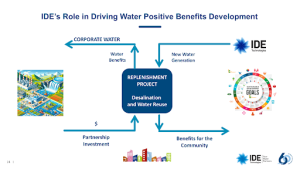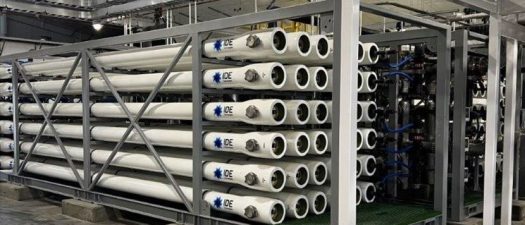Across industries, the move toward sustainability is no longer optional — it’s essential. .
Water Positive in Action: Creating New Water and Driving Replenishment

Water is no longer just a utility. It’s a crisis, an opportunity, and a call to action. Across the globe, 2 billion people lack access to safe drinking water. Over 3.6 billion live without proper sanitation, and 2.3 billion can’t even wash their hands safely. The water crisis is already here, and it’s only accelerating.
In this context, a new sustainability mindset is emerging. It’s called being water positive. And it’s more than just doing less harm. It’s about doing more good with intentionality and additionality at its core.
As IDE Technologies celebrates 60 years of innovation in desalination and water treatment, the company is taking bold steps to lead the way toward a water-positive future. This isn’t just a shift in operations, it’s a shift in philosophy.
Why Water Positivity Matters Now
Water scarcity isn’t just an environmental concern – it’s a global risk multiplier. Driven by climate change, pollution, and population growth, water insecurity threatens industries, economies, and entire ecosystems.
Consider the numbers:
- The annual economic value of freshwater ecosystems is estimated at $58 trillion—nearly 60% of global GDP.
- Industrial risks linked to water availability reach $439 billion.
- In many low-income countries, 80% of agricultural jobs depend directly on water.
For businesses, water has become a strategic asset. Supply chain resilience, regulatory compliance, and market positioning are all at stake. In this new reality, companies must move from water conservation to water regeneration.
What Does It Mean to Be Water Positive?
Water positivity means replenishing more water than you consume. It’s not just about reducing withdrawals, it’s about creating new water resources and restoring the balance in water-stressed ecosystems.
The gold standard for tracking this is Volumetric Water Benefit Accounting (VWBA). This method quantifies the hydrological, quality, and availability impacts of water stewardship in measurable units like cubic meters or gallons. In other words, it’s how you prove you’re giving more than you take.
Water positivity is achieved by combining:
- Insetting: Reducing water use and improving efficiency inside your operations.
- Offsetting: Investing in projects that generate or restore water outside your operations.
How to Become Water Positive
1. Inside the Fence: Maximize Water Efficiency
Industrial processes consume enormous volumes of water, often in regions that are already under stress. Technologies like IDE’s Pulse Flow Reverse Osmosis (PFRO™) and MAXH₂O systems enable high recovery rates even in harsh conditions.
For example, a semiconductor fab in Israel achieved continuous water reuse using IDE’s PFRO™, overcoming extreme fouling where conventional RO failed. Similarly, in the mining sector, IDE’s systems helped the Rampura Agucha zinc mine in India achieve a 90% recovery rate despite high sulfate and metal loads.
2. Outside the Fence: Replenishment Projects
Insetting alone isn’t enough. To become water positive, companies must also generate new water through initiatives like wastewater reuse and seawater desalination.
Take the Cherokee Metropolitan District in Colorado. IDE helped build an indirect potable reuse facility using membrane bioreactors and PFRO technology. With intentionality, the system was designed to achieve up to 95% water recovery and directly support agricultural irrigation by replenishing local aquifers with ultra-low salinity, PFAS-free water. This additionality ensures that farmers receive consistently high-quality water, free from contaminants, resulting in improved crop yields and healthier soils, while also benefiting both communities and ecosystems.
Or consider the Carlsbad Desalination Plant in California, which provides 10% of San Diego’s drinking water. Since commissioning, it has delivered over 124 billion gallons of potable water, proving that desalination can be both scalable and sustainable. By creating new water directly from the ocean, the plant significantly relieves pressure on natural freshwater resources such as rivers, lakes, and aquifers, helping to preserve these ecosystems and support long-term regional water security.
The Water Benefits Market: Like Carbon Credits, But for Water
Just as carbon markets incentivize emissions reductions, a new Water Benefits Market is emerging. Companies can invest in third-party replenishment projects to offset their water footprint.
Project developers like IDE play a critical role in this ecosystem, identifying and implementing custom solutions near water-stressed regions. These projects create measurable benefits aligned with SDG 6: Clean Water and Sanitation—and they also enhance regional water security and community resilience.

From Vision to Impact: Real-World Leaders
Global companies are stepping up.
Microsoft, for instance, has pledged to be water positive by 2030. It’s investing in high-water stress basins, cutting water use in data centers, and improving access for underserved communities, especially women living in poverty.
IDE Technologies is pushing the envelope with facilities like Sorek 2 in Israel. The world’s first steam-driven desalination plant, Sorek 2 cuts carbon emissions by 30% compared to previous designs. It captures CO₂ for reuse, manufactures its own chemicals, and operates at one of the lowest costs worldwide – just $0.40 per cubic meter.
A Call to Action: Your Role in the Water Positive Cycle
Becoming water positive is not a solo journey. It requires collaboration across sectors – between corporations, NGOs, governments, and communities. At IDE, we believe water positivity is not only possible – it’s essential.
We invite companies to join us as technology partners on this journey. By choosing IDE, you gain the benefit of decades of proven experience, innovation, and reliability in water treatment and desalination. Together, we can create New Water, rebalance our water systems, and build a sustainable, resilient future for everyone.
Take the next step – partner with IDE and be part of the global movement for water positivity.
















